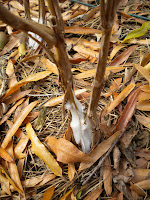




I love having a passionate hobby, because it promotes theme gifts. This Christmas, gardening ruled. Yes, I got that composter (thank you, Pam), along with a bucket for collecting my food scraps.
My daughter Anna, who is a huge Etsy fan, also gave me seeds from "The Bear Foot Shaman," a vendor named Radonna Fox who is an aromatherapist, gardener, and collector of
heirloom medicinal, vegetable, and flower seeds. I can't wait to try to grow these beauties. Have you ever seen a watermelon more beautiful than this?
My cousins and locavore comrades Sharon and Kristina (be sure to check out Kristina's Confections, yum!) sent a beautifully crafted slingshot and seed bombs. I'll be bombing my own yard, as well as my neighborhood.
And last, but not least, my ever-so-thoughtful husband put much needed garden stakes under the tree, along with this fabulous weeder for old ladies called the "Reach Weeder." It's light weight and expands in length so you don't have to bend over. But even more impressive is the Reach Weeder's blade. After a work out in the garden, I can take it to the beach to fight off sharks.













































